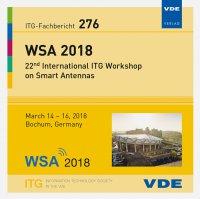On the Impact of Radio Channel over REM-Aware UAV-Aided Mobile Networks
Conference: WSA 2018 - 22nd International ITG Workshop on Smart Antennas
03/14/2018 - 03/16/2018 at Bochum, Deutschland
Proceedings: WSA 2018
Pages: 6Language: englishTyp: PDF
Personal VDE Members are entitled to a 10% discount on this title
Authors:
Mignardi, Silvia; Buratti, Chiara; Verdone, Roberto (DEI, University of Bologna, Bologna, Italy)
Abstract:
This paper studies the use of Unmanned Aerial Vehicles (UAVs) as support to today’s cellular networks. UAVs operate like Small Cells moving according to traffic and service needs; coverage and capacity become adaptive to time-spatial variations of the user demand. The Unmanned Aerial Base Station (UABS) is requested to fly over areas in which users requesting service are not covered by the nearest Terrestrial Base Station (TBS) in real-time. In our scenario users ask for a video streaming service, having stringent requirements in downlink throughput but a latency of tens of seconds. We are considering a UAV trajectory design that accounts for the actual position of unsatisfied users grouped in clusters. The trajectory is computed by a central controller as a function of the distance of the UABS from the next cluster, user density, energy consumed by drone and spatial fairness. In this paper we analyze the impact of having at disposal precise Radio Environment Map (REM) information and different antenna systems mounted on the drone. Since these techniques impact the link between the UABS and ground users, network throughput and coverage range are affected in different ways for each solution. Simulation results will show for each case the performance achieved by the system.


